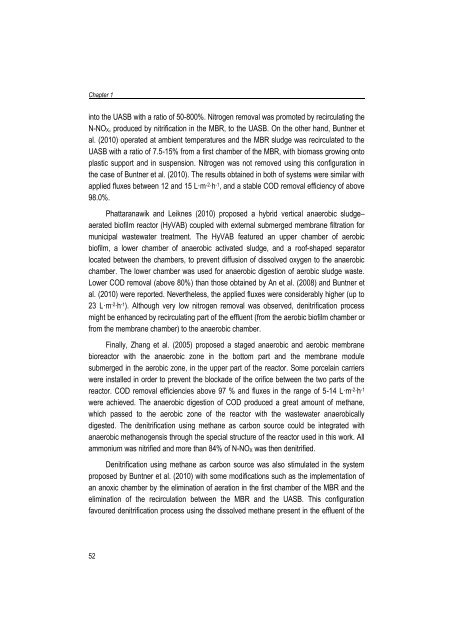Combining submerged membrane technology with anaerobic and ...
Combining submerged membrane technology with anaerobic and ...
Combining submerged membrane technology with anaerobic and ...
You also want an ePaper? Increase the reach of your titles
YUMPU automatically turns print PDFs into web optimized ePapers that Google loves.
Chapter 1into the UASB <strong>with</strong> a ratio of 50-800%. Nitrogen removal was promoted by recirculating theN-NO X, produced by nitrification in the MBR, to the UASB. On the other h<strong>and</strong>, Buntner etal. (2010) operated at ambient temperatures <strong>and</strong> the MBR sludge was recirculated to theUASB <strong>with</strong> a ratio of 7.5-15% from a first chamber of the MBR, <strong>with</strong> biomass growing ontoplastic support <strong>and</strong> in suspension. Nitrogen was not removed using this configuration inthe case of Buntner et al. (2010). The results obtained in both of systems were similar <strong>with</strong>applied fluxes between 12 <strong>and</strong> 15 L·m -2 ∙h -1 , <strong>and</strong> a stable COD removal efficiency of above98.0%.Phattaranawik <strong>and</strong> Leiknes (2010) proposed a hybrid vertical <strong>anaerobic</strong> sludge–aerated biofilm reactor (HyVAB) coupled <strong>with</strong> external <strong>submerged</strong> <strong>membrane</strong> filtration formunicipal wastewater treatment. The HyVAB featured an upper chamber of aerobicbiofilm, a lower chamber of <strong>anaerobic</strong> activated sludge, <strong>and</strong> a roof-shaped separatorlocated between the chambers, to prevent diffusion of dissolved oxygen to the <strong>anaerobic</strong>chamber. The lower chamber was used for <strong>anaerobic</strong> digestion of aerobic sludge waste.Lower COD removal (above 80%) than those obtained by An et al. (2008) <strong>and</strong> Buntner etal. (2010) were reported. Nevertheless, the applied fluxes were considerably higher (up to23 L·m -2 ∙h -1 ). Although very low nitrogen removal was observed, denitrification processmight be enhanced by recirculating part of the effluent (from the aerobic biofilm chamber orfrom the <strong>membrane</strong> chamber) to the <strong>anaerobic</strong> chamber.Finally, Zhang et al. (2005) proposed a staged <strong>anaerobic</strong> <strong>and</strong> aerobic <strong>membrane</strong>bioreactor <strong>with</strong> the <strong>anaerobic</strong> zone in the bottom part <strong>and</strong> the <strong>membrane</strong> module<strong>submerged</strong> in the aerobic zone, in the upper part of the reactor. Some porcelain carrierswere installed in order to prevent the blockade of the orifice between the two parts of thereactor. COD removal efficiencies above 97 % <strong>and</strong> fluxes in the range of 5-14 L·m -2 ∙h -1were achieved. The <strong>anaerobic</strong> digestion of COD produced a great amount of methane,which passed to the aerobic zone of the reactor <strong>with</strong> the wastewater <strong>anaerobic</strong>allydigested. The denitrification using methane as carbon source could be integrated <strong>with</strong><strong>anaerobic</strong> methanogensis through the special structure of the reactor used in this work. Allammonium was nitrified <strong>and</strong> more than 84% of N-NO X was then denitrified.Denitrification using methane as carbon source was also stimulated in the systemproposed by Buntner et al. (2010) <strong>with</strong> some modifications such as the implementation ofan anoxic chamber by the elimination of aeration in the first chamber of the MBR <strong>and</strong> theelimination of the recirculation between the MBR <strong>and</strong> the UASB. This configurationfavoured denitrification process using the dissolved methane present in the effluent of the52
















